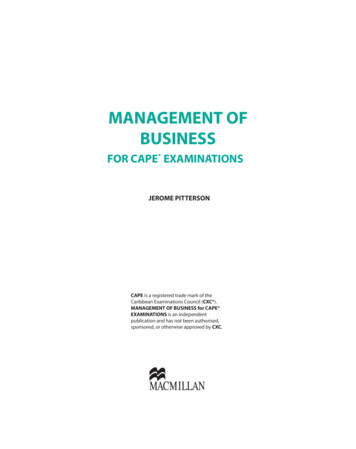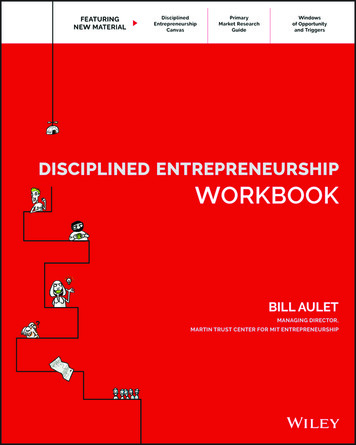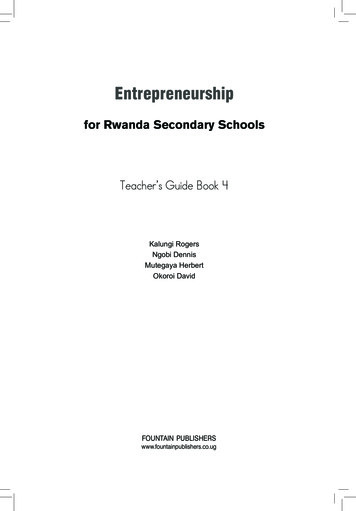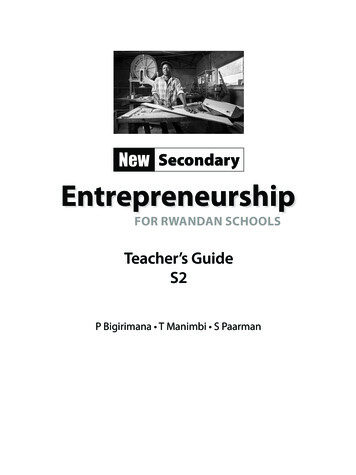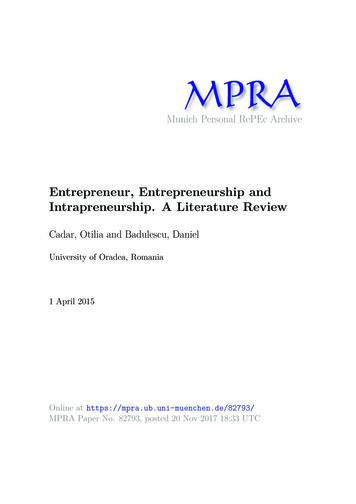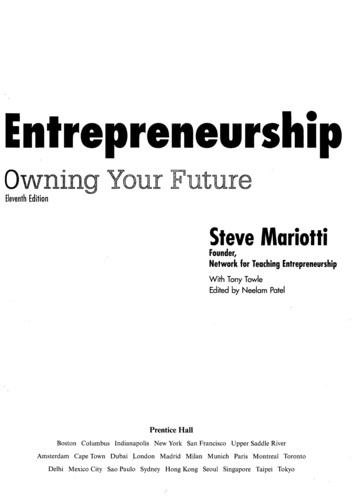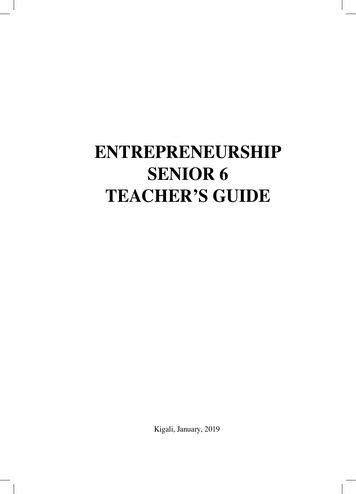
Transcription
ENTREPRENEURSHIPSENIOR 6TEACHER’S GUIDEKigali, January, 2019
Copyright 2019 Rwanda Education BoardAll rights reserved.This Teacher’s Guide is the property of Rwanda Education Board.Credit should be given to REB when the source of this book is quoted.
FOREWORDDear teacher,Rwanda Education Board is honoured to present Senior 6 entrepreneurship teacher sguide which serves as a guide to competence-based teaching and learning to ensureconsistency and coherence in the learning of the entrepreneurship subject. TheRwandan educational philosophy is to ensure that learners achieve full potential atevery level of education which will prepare them to be well integrated in society andexploit employment opportunities.In line with efforts to improve the quality of education, the government of Rwandaemphasizes the importance of aligning teaching and learning materials with the syllabusto facilitate their learning process. Many factors influence what they learn, how wellthey learn and the competences they acquire. Those factors include the relevance ofthe specific content, the quality of teachers’ pedagogical approaches, the assessmentstrategies and the instructional materials available. We paid special attention to theactivities that facilitate the learning process in which learners can develop ideas andmake new discoveries during concrete activities carried out individually or with peers.With the help of the teachers, learners will gain appropriate skills and be able to applywhat they have learnt in real life situations. Hence, they will be able to develop certainvalues and attitudes allowing them to make a difference not only to their own life butalso to the nation.This is in contrast to traditional learning theories which view learning mainly as a processof acquiring knowledge from the more knowledgeable who is mostly the teacher. Incompetence-based curriculum, learning is considered as a process of active buildingand developing of knowledge and understanding, skills and values and attitude by thelearner where concepts are mainly introduced by an activity, situation or scenario thathelps the learner to construct knowledge, develop skills and acquire positive attitudesand values.In addition, such active learning engages learners in doing things and thinking aboutthe things they are doing and they are encouraged to bring their own real experiencesand knowledge into the learning processes. In view of this, your role is to: Plan your lessons and prepare appropriate teaching materials. Organize group discussions for learners considering the importance of socialconstructivism suggesting that learning occurs more effectively when the learnerworks collaboratively with more knowledgeable and experienced people. Engage learners through active learning methods such as inquiry methods, groupdiscussions, research, investigative activities and group and individual workactivities.Entrepreneurship Teacher’s Guide For Senior Sixi
Provide supervised opportunities for learners to develop different competencesby giving tasks which enhance critical thinking, problem solving, research,creativity and innovation, communication and cooperation. Support and facilitate the learning process by valuing learners’ contributions inthe class activities. Guide learners towards the harmonization of their findings. Encourage individual, peer and group evaluation of the work done in theclassroom and use appropriate competence-based assessment approaches andmethods.To facilitate you in your teaching activities, the content of this teacher s guide is selfexplanatory so that you can easily use it. It is divided in 3 parts:The part 1:Explains the structure of this book and gives you the methodological guidance;The part 2:Gives the sample lesson plans as reference for your lesson planning process;The part 3:Provides details the teaching guidance for each concept given in the student book.Even though this teacher s guide contains the answers for all activities given in thelearner’s book, you are requested to work through each question and activity beforejudging learner’s findings.I wish to sincerely appreciate all people who contributed towards the development ofthis teacher s guide, particularly REB staff who organized the whole process from itsinception. Special gratitude goes to the University of Rwanda which provided expertsin design and layout services, illustrations and image anti-plagiarism, lecturers andteachers who diligently worked to successful completion of this book. Any commentor contribution would be welcome for the improvement of this textbook for the nextedition.Dr. NDAYAMBAJE IrénéeDirector General of REBiiEntrepreneurship Teacher’s Guide For Senior Six
ACKNOWLEDGEMENTI wish to express my appreciation to all the people who played a major role indevelopment of this Senior 6 entrepreneurship teacher s guide. It would not have beensuccessful without active participation of different education stakeholders.I owe gratitude to different Universities and schools in Rwanda that allowed their staffto work with REB in the in-house textbooks production project. I wish to extend mysincere gratitude to lecturers, teachers and all other individuals whose efforts in oneway or the other contributed to the success of writing of this textbook.Special acknowledgement goes to the University of Rwanda which provided experts indesign and layout services, illustrations and image anti-plagiarism.Finally, my word of gratitude goes to the Rwanda Education Board staff particularlythose from Curriculum, Teaching and Learning Resources Department (CTLR) whowere involved in the whole process of in-house textbook writing.Joan Murungi,Head of CTLREntrepreneurship Teacher’s Guide For Senior Sixiii
TABLE OF CONTENTSFOREWORD. iACKNOWLEDGEMENT.iiiTABLE OF CONTENTS. ivPART I. GENERAL INTRODUCTION.viiiIntroduction. viii1.1. The structure of the guide . viii1.2 Methodological guidance.x1.1.2 Developing competences.x1.2.2 Addressing cross cutting issues. xi1.2.3 Attention to special educational needs and inclusive education. xiii1.2.4. Guidance on assessment . xv1.2.5 Students’ learning styles and strategies to conduct teaching and learning process.xviii1.2.6. Skills Labs Method Of Teaching. xxi1.2.7. Student Business Club. xxiiiPART II: SAMPLE LESSON PLANS . xxviPART III: UNIT DEVELOPMENT . xxxiUNIT 1: SOCIO-ECONOMIC DEVELOPMENT. 11.1 Unit Prerequisite .11.2 Cross-cutting issues to be addressed.11.3 Generic competencies to be developed. 21.4 List of lessons (including assessment).41.5 Use of Skills Lab Method: Lab 1.211.6 Summary of the unit . 231.7 Additional Information: . 231.8 End of unit assessment . 231.9 Additional Activities.29UNIT 2: ENVIRONMENTAL IMPACT ASSESSMENT (EIA) . 312.1 Unit Prerequisite .312.2 Cross-cutting issues to be addressed.312.3 Generic competencies to be developed . 322.4 List of lessons (including assessment).362.5 Use of skills Lab Method: Lab 2.512.6 Summary of the Unit. 532.7 Additional Information.542.8 End of Unit 2 Assessment. 552.9 Additional activities.58ivEntrepreneurship Teacher’s Guide For Senior Six
Unit 3: CUSTOMS PROCEDURES .593.1. Unit Prerequisite.593.2. Cross-cutting issues to be addressed.593.3. Generic competencies to be developed.603.4. List of lessons (including assessment). 613.5. Use of Skills Lab Method: Lab 3.823.6. Summary of the Unit.843.7. Additional Information.843.8. End Unit Assessment:.853.9. Additional Activities.87Unit 4: FINANCIAL MARKETS. 914.1. Unit Prerequisite. 914.2.Crosscutting issues to be addressed. 914.3.Generic Competencies.924.4.List of lessons (including assessment).954.5. Use of skills lab method: Lab 4. 1204.6.Summary of the unit.1224.7.End of Unit 4 Assessment.1234.8.Additional Information. 1264.9.Additional activities.127UNIT 5: FINANCIAL STATEMENT. 1295.1 Unit Prerequisite. 1295.2 Cross-cutting issues to be addressed. 1295.3 Generic competencies . 1305.4 List of lessons (including assessment). 1365.5. Use of skills Lab Method: Lab 5. 1595.6 End Unit Summary. 1605.7 Additional Information. 1625.8 End of unit 5 assessment . 1665.9 Additional Activities .174UNIT 6: STOCK CONTROL1776.1. Unit Prerequisite.1776.2. Cross-cutting issues to be addressed.1776.3. Generic competencies to be developed. 1786.4.List of lessons (including assessment). 1826.5. Use of skills lab method: Lab 6. 197Entrepreneurship Teacher’s Guide For Senior Sixv
6.6.Summary of the unit. 1996.7.Additional Information.2006.8.End unit 6 Assessment. 2026.9.Additional Activities.206UNIT 7: BUSINESS PLAN FOR AN ENTERPRISE.2077.1.Unit Prerequisite . 2077.2.Cross-cutting issues to be addressed. 2077.3.Generic competencies .2087.4.List of lessons (including assessment). 2107.5.Use of Skills Lab Method: Lab 7.2317.6.End of unit Summary . 2337.7.Addition information. 2347.8.End of Unit 7 Assessment. 2377.9.Additional Activities .240UNIT 8: OPERATIONAL BUSINESS PLAN FOR AN ENTERPRISE. 2418.1. Unit Prerequisite.2418.2. Cross-cutting issues to be addressed.2418.3. Generic competencies . 2428.4. List of lessons (including assessment).2448.5. Use of Skills Lab Method: Lab 8.2638.6 End Unit Summary.2648.7. Additional information.2668.8. End of Unit 8 Assessment. 2673.9. Additional Activities.271UNIT 9: QUALITY ASSURANCE AND QUALITY COMPLIANCE INBUSINESS . 2739.1.Unit Prerequisite . 2739.2.Cross-cutting issues to be addressed. 2739.3.Generic competencies to be developed . 2749.4.List of lessons (including assessment). 2789.5.Use of skills lab method: Lab 9. 2979.6.Summary of the Unit.2999.7.Additional Information.3009.8.End of Unit 9 Assessment. 3019.9.Additional activities.304viEntrepreneurship Teacher’s Guide For Senior Six
UNIT 10: WORK HABITS AND BEHAVIOR . 30510.1. Unit Prerequisite.30510.2. Cross-cutting issues to be addressed.30510.3. Generic competencies.30610.4. List of lessons/sub-heading (including assessment).30910.5. Use of Skills Lab Method: Lab 10. 32310.6. Summary of the unit. 32510.7. Additional information for teachers.32610.8. End unit assessment.32610.9. Additional activities. 328UNIT 11: WORK SAFETY AND HEALTH .33111.1. Unit Prerequisite.33111.2. Cross-cutting issues to be addressed.33111.3. Generic competencies. 33311.4 List of lessons /sub-heading (including assessment). 33511.5. Use of Skills Lab Method:Lab 11.37011.6. Summary of the Unit: Safety and Health at Workplace. 37311.7. Additional Information for teachers. 37311.8. Additional Activities. 38211.9. End Unit Assessment.384Bibliography. 385ANNEXES. 390Entrepreneurship Teacher’s Guide For Senior Sixvii
PRESENTATION OF THE TEACHER S GUIDEPART I. GENERAL INTRODUCTIONIntroductionThe purpose of this teacher guide is to help you implement the entrepreneurshipsyllabus. It is designed to stimulate you to create exciting and meaningful lessons byenabling you to choose relevant and purposeful activities and teaching strategies. Iwill encourage you to research and look for new and challenging ways of facilitatingstudents’ learning. The teacher guide and the syllabus must be used side by side. Thesyllabus states the learning outcomes for the subject and each unit, and outlines thecontent and skills that students will learn, and the assessment requirements.The teacher guide provides direction for you in using the outcomes approach in yourclassroom using a step by step approach. This teacher guide provides examples ofteaching and learning strategies for entrepreneurship, elaboration of suggestedactivities and content, detailed information on how to mark assessment tasks and theresources needed to teach entrepreneurship.1.1. The structure of the guideThis section presents the overall structure, the unit and sub-heading structure to helpteachers to understand the different sections of this guide and what they will find ineach section.Overall structureThe whole guide has three main parts as follows:Part I: General Introduction.This part provides general guidance on how to develop the generic competences, howto integrate cross cutting issues, how to cater for learners with special educationalneeds, active methods and techniques of teaching entrepreneurship and guidance onassessment.Part II: Sample lesson planThis part provides a sample lesson plan, developed and designed to help the teacherdevelop their own lesson plans.Part III: Unit developmentThis is the core part of the guide. Each unit is developed following the structure below.The guide ends with references.viiiEntrepreneurship Teacher’s Guide For Senior Six
Structure of a unitEach unit is made of the following sections:1. Unit title: From the syllabus2. Key unit competence: From the syllabus3. Prerequisites (knowledge, skills, attitudes and values)This section indicates knowledge, skills and attitudes required for the success of theunit. The competence-based approach calls for connections between units/topicswithin a subject and interconnections between different subjects. The teacher will findan indication of those prerequisites and guidance on how to establish connections.Cross-cutting issues to be addressed: This section suggests cross-cutting issuesthat can be integrated depending on the unit content. It provides guidance on how tocome up with the integration of the issue. Note that the issue indicated is a suggestion;teachers are free to take another cross-cutting issue taking into consideration thelearning environment.Guidance on the introductory activity: Each unit starts with an introductory activityin the learner’s book. This section of the teacher’s guide provides guidance on howto conduct this activity and related answers. Note that learners may not be able tofind the right solution but they are invited to predict possible solutions or answers.Solutions are provided by learners gradually through discovery activities organized atthe beginning of lessons or during the lesson.List of lessons/sub-heading: This section presents in a table suggestion on the list oflessons, lesson objectives copied or adapted from the syllabus and duration for eachlesson. Each lesson /subheading is then developed.End of each unit: At the end of each unit the teacher’s guide provides the followingsections: Summary of the unit which provides the key points of content developed in thestudent’s book. Additional information which provides additional content compared to thestudent’s book for the teacher to have a deeper understanding of the topic. End unit assessment which provides the answers to questions of end unitassessment in the textbook and suggests additional questions and relatedanswers to assess the key unit competence. Additional activities: remedial, consolidation and extended activities. Thepurpose of these activities is to accommodate each learner (slow, average andgifted) based on end unit assessment results.Entrepreneurship Teacher’s Guide For Senior Sixix
Structure of each-sub headingEach lesson/sub-heading is made of the following sections: Lesson /Sub-heading title Prerequisites/Revision/IntroductionThis section gives a clear instruction to teacher on how to start the lesson Teaching resources: This section suggests the teaching aids or other resourcesneeded in line with the activities to achieve the learning objectives. Teachers areencouraged to replace the suggested teaching aids by the ones available in theirrespective schools and based on learning environment. Learning activities: This section provides a short description of the methodologyand any important aspect to consider. It provides also answers to learningactivities with cross reference to text book: Exercises/application activities: This provides questions and answers forexercises/ application activities.1.2 Methodological guidance1.1.2 Developing competencesSince 2015, Rwanda shifted from a knowledge based to a competency based curriculumfor pre-primary, primary and general secondary education. This called for changing theway of learning by shifting from teacher centered to a learner-centered approach.Teachers are not only responsible for knowledge transfer but also for fostering children’slearning achievement, and creating safe and supportive learning environment. It impliesalso that a learner has to demonstrate what he/she is able to do using the knowledge,skills, values and attitude acquired in a new or different or given situation.The competence-based curriculum employs an approach of teaching and learningbased on discrete skills rather than dwelling on only knowledge or the cognitivedomain of learning. It focuses on what learner can do rather than what learners know.Learners develop basic competences through specific subject unit competences withspecific learning objectives broken down into knowledge, skills and attitudes. Thesecompetences are developed through learning activities disseminated in learnercentered rather than the traditional didactic approach. The student is evaluated againstset standards to achieve before moving on.In addition to specific subject competences, learners also develop generic competenceswhich are transferable throughout a range of learning areas and situations in life.Below are example of how generic competences can be developed in the subject ofEntrepreneurship Critical Thinking: Learners analyze their environment or community for problemsor challenges faced and the causes. After they suggest possible remedies to theidentified problem during generation of business ideas and opportunities.xEntrepreneurship Teacher’s Guide For Senior Six
Research and problem solving: Learners collect data using interviews,questionnaires and any other tool, analyse the data gathered and suggestsolutions regarding business customer behaviour in a research in business unit. Creativity and Innovation: Learners analyse resources such waste materialsexisting in the community or environment. They develop or come up with newways of utilizing such resources or how they can be put to use again in generatingbusiness ideas and opportunities. Communication Skills: Learners can present themselves and their abilities bywriting application letters or CVs to potential employers. Can write differentdocuments such Memos, Notices in a clear and understandable language toconvey on information effectively during interpersonal communication Teamwork, Cooperation, Personal and Interpersonal management and lifeskills: Learners in teams complete different tasks where each may take on adifferent role while complementing each other’s strengths and weaknesses inteam leadership. Alternatively, teams compete to prepare and present a businessplan for their team projects to potential investors or financial institutions. Lifelong Learning: Learners lead a problem solving and decision making processin a team. Do a self-evaluation to identify own areas of strengths, areas ofweaknesses and propose strategies for enhancing and improving in a teamleadership. Alternatively, learners analyse a scenario involving conflicts at aworkplace, identify the causes, suggest solutions and propose how they willapply the learned lessons to similar situations in real situations1.2.2 Addressing cross cutting issues.Among the changes in the competence-based curriculum is the integration of crosscutting issues as an integral part of the teaching learning process-as they relate to andmust be considered within all subjects to be appropriately addressed. There are eightcross cutting issues identified in the national curriculum framework. (See annex 2).Some cross cutting issues may seem specific to particular learning areas/subjects butthe teacher need to address all of them whenever an opportunity arises. In addition,learners should always be given an opportunity during the learning process to addressthese cross cutting issues both within and out of the classroom.Below are examples on how crosscutting issues can be addressed in your subject: Gender education: Remind learners that both males and females have similaropportunities, rights and obligations in the workplace, and therefore need to betreated fairly and equally when dealing with contracts or resolving conflicts. People’sopinion of gender roles should not deny or hinder one’s right or respons
Rwanda Education Board is honoured to present Senior 6 entrepreneurship teacher s guide which serves as a guide to competence-based teaching and learning to ensure consistency and coherence in the learning of the entrepreneurship subject. The Rwandan educational philos

